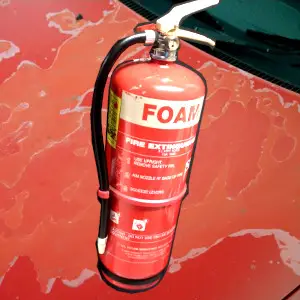Car paint is made to withstand all types of weather, and even minor impacts. The paint job is usually made to look good for the life of the vehicle.
However, some events or substances can damage car paint. Is fire extinguisher spray one of them?
Read on…
Can a Fire Extinguisher Damage Car Paint?
Yes, the spray from certain types of fire extinguishers can damage car paint.
Ammonium phosphate, halon 1301 or halon 1211 can damage car paint. Multi-purpose ABC dry chemical fire extinguishers that are often stored in or used around vehicles can also harm the paint job.
Dry chemical (powder) fire extinguishers that are not CO2 can leave residue on a car’s surface. Fire extinguisher powder can be sodium bicarbonate, which will appear as a white dust. Sodium bicarbonate will not hurt the paint as long as it is removed quickly after being sprayed. It is best to remove the spray residue immediately after and do not let it sit for too long.
However, if you do not wash the car for more than a week, the powder can become encrusted on the surface and cause corrosion. This could leave a white or reddish color coating on the car’s paint. This can harm the resale value of the vehicle, and just not look very good.
Fire Extinguisher Spray Can Cause Corrosion
Some types of fire extinguisher sprays can be very corrosive and abrasive to surfaces, including the painted surface of a car. Class B fire extinguishers are particularly corrosive to paint.
If fire extinguisher spray gets inside the hood or crevices in the vehicle’s structure, it can cause corrosion which will damage the car over the long term. It can also damage the electrical system, such as the power steering, lights, and radio.
And if the spray gets into vehicle nooks and crannies, it cannot be fully removed unless the car is dissassembled.

How To Remove Fire Extinguisher Spray From Car Paint?
Removing fire extinguisher from car paint is not difficult, as long as it has not been sitting for too long. You can use an ordinary garden hose and soap to wash it off.
Cleaning agents you can use include isopropyl alcholol diluted 50% with warm water, general purpose cleaning solution, or car wash soap. Wipe down the vehicle with a damp rag first and then apply the cleaning solution.
If the powder has sodium bicarbonate or potassium bicarbonate, it can be nuetralized using a mixture of vinegar (2-5%) and hot water (95-98%).
Lava soap mixed with ajax cleaning powder can also work along with a rag or scrub pad. The soap may need to sit for a few minutes before being wiped off.
Good Cleaning Products to Use for Fire Extinguisher Residue
Here are a few highly-rated cleaning products that work well with water to clean up any fire extinguisher dust or residue from your car’s paint:
Simple Green 13005CT Industrial Cleaner and Degreaser
Meguiar’s G7164 Gold Class Car Wash Shampoo and Conditioner
As an Amazon Associate, SelectSafety earns commissions from qualifying purchases made through links in this post.
What Fire Extinguisher Type Should Not Be Used On Paint?
Flammable paints require a special fire extinguisher to put out. This is called a class B fire extinguisher and contains dry chemicals in the form of powder or foam. These contents can include ammonium phosphate, halon 1301 or halon 1211 which can damage car paint.
However, if you are ever in or near an automobile accident and need to use a fire extinguisher, then ruining the paint job with spray may be the last of your worries. This can happen if the engine catches on fire, or a flame touches the upholstery somehow causing it to ignite (from a cigarette, for example).
If a car is in a garage and there is a small garage fire, a fire extinguisher will need to be used. This can end up spraying the vehicle as well. At this point, it is best to drive the car out of the garage and wash it as soon as it is safe to do so.
Substances That Can Damage Car Paint
For an overview of which substances can damage car paint, here is a brief list:
- Fire extinguisher powder
- Bugs
- Tree sap
- Gas
- Coffee & soda
- Brake Fluid
- Bird droppings
- Silly string
- Shaving cream
- Dust
Each substance will break down car paint at different rates. This also depends on if the car has been waxed recently and how durable the paint is. Leaving any of these substances on the surface of a car long enough will result in corrosion and the paint job being permanently damaged.
In Conclusion
When it comes to car paint, it is always best to act quickly and remove any substance from the surface that may be acidic or corrosive. Playing it safe and getting the car washed as soon as it is sprayed with a fire extinguisher will make sure the paint is not damaged. This means your car will continue to look good and keep its value.

